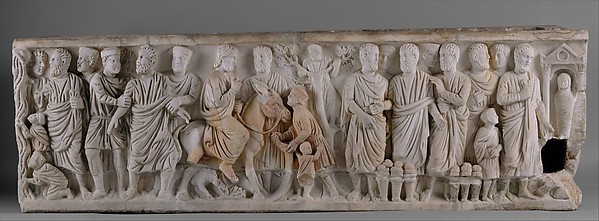
Sarcophagus with Scenes from the
Lives of Saint Peter and Christ (early 4th century) Metropolitan Museum of Art
(New York) ■ The sarcophagus was carved about the time when
Christianity was first recognized as a legal faith within the Roman Empire. The
two legendary scenes of the Miracle of Saint Peter Drawing Water from a Rock in
His Jail Cell and Saint Peter’s Arrest in Rome, crisply carved in powerful,
deep relief at the left, are among the earliest surviving images depicting
Peter’s special relationship with Rome. When the sarcophagus was identified in
1879, only the lower legs, with scenes from the life of Christ on the right,
survived (see image). Incorrect identification of the figures led to inaccurate
restoration of the upper portion of the scenes carved in low relief.
Originally, four scenes from Christ’s life decorated the sarcophagus: the Entry
into Jerusalem, the Cure of the Man Born Blind, the Multiplication of the
Loaves, and the Raising of Lazarus. In the modern restoration, the Cure of the Man
Born Blind was omitted, with the man’s feet used instead for the small,
frightened child in the Entry into Jerusalem. Roughly carved in low relief on
the ends are two Old Testament scenes foretelling mankind’s salvation by
Christ: Three Hebrews in the Fiery Furnace and Adam and Eve after the Fall by
the Tree of Knowledge ■


